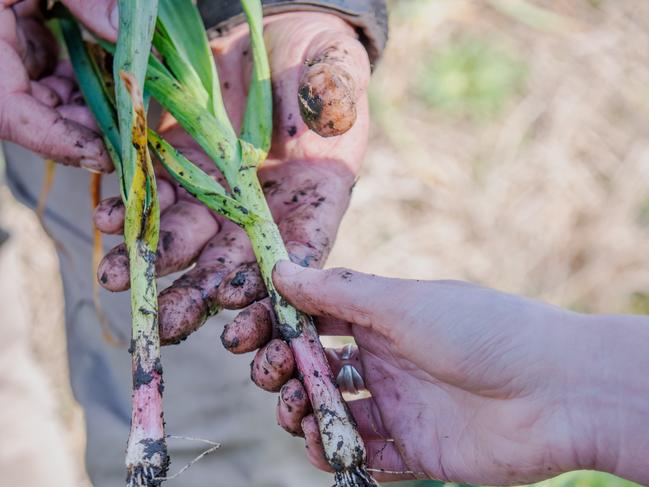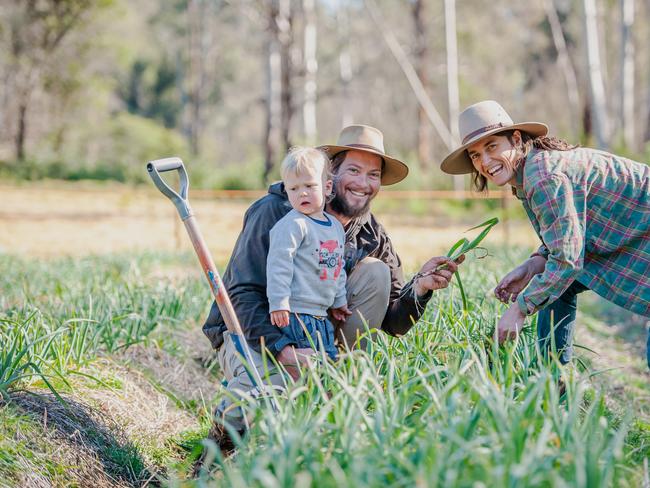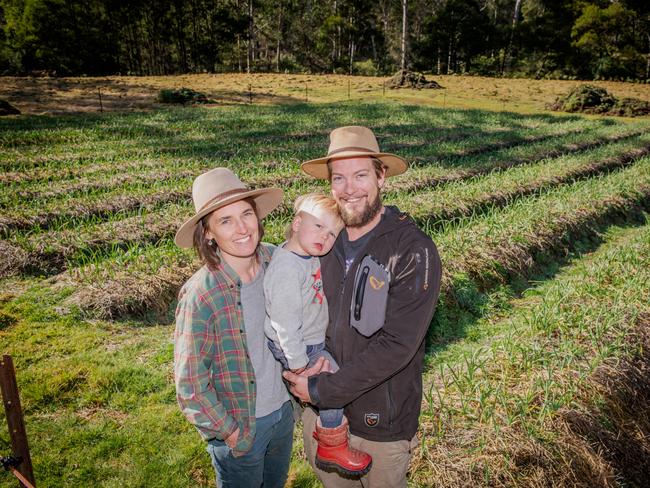Young couple reap financial rewards from small farm
Self-sufficient living was always on Justine Ward and Brett Dawson’s radar and now they are able to make an income from their lifestyle property.

Earning a living off a lifestyle property is the Holy Grail for small acreage owners, and Brett Dawson and Justine Ward believe they have found that lucrative treasure.
The couple has 20ha at Waterholes on the Nicholson River, north of Bairnsdale in East Gippsland, which they bought three years ago seeking the ultimate work life balance and self-sufficient living.
But Brett, who worked in civil construction, and Justine, a social worker at the local hospital, quickly discovered the best laid plans don’t always run smoothly in farming as bushfires struck only four months after settlement, followed by the Covid pandemic and then one of the wettest years on record.
“It was pretty wild,” Brett said.
But despite the hurdles making Brett and Justine move a little slower than planned, they still moved with purpose.
Their property features high quality topsoil from the rich river flats and the couple settled on garlic as their crop of choice. Favourable growing conditions and climate, a reliable water supply, strong local market outlets and minimal inputs for maximum returns shaped their decision to create Waterholes Garlic.

Their venture is still in its foundation stages and is contained to just three quarters of an acre but they have doubled production this year from 500kg to a tonne and hope to double that again to produce at least two tonnes of garlic each year, which would sustain the couple financially without the need for off-farm income.
LOSS AND LEARNING
In their first cropping year, the couple planted 10kg of red garlic seed and 10kg of white but prolonged rain resulted in a total loss of the entire white crop. They also had problems this year with the conditions causing garlic to grow too big too quickly, which resulted in splitting and the loss of about 50kg of produce.

“It’s been so wet the last few years so we’ve picked the most difficult time to start growing garlic,” Justine said.
“But it hasn’t been the worst thing because we’ve had to understand how important it is to get the drying process right. Garlic is so good at absorbing the moisture in the air. If you don’t dry it properly the shelf life diminishes and it makes it prone to going mouldy and shooting early.”
Brett is currently building a 12m by 8m barn-style shed with wood from their own Lucas mill to help dry the garlic. The shed, estimated to cost about $10,000 with concrete floor, will be opened up for ventilation and feature fans with dehumidifiers.
“We are building the new drying shed because we didn’t want the garlic inside the house,” Brett said.
“It has been so wet that we have had to bring the whole crop inside to dry it in the house. Garlic smells nice but not when it’s in everything.”

LABOUR INTENSIVE
The garlic crop is planted, grown and harvested within nine months.
Planting is at the end of March and picking is early December, depending on the season. Garlic is hung to cure for four to six weeks before it is ready for sale in mid to late January.
“Prior to planting we build up the rows and turn over all the topsoil and mix in some sheep manure. We’ve got a template for our holes and spacings for our garlic so then we come and drop the garlic cloves in,” Brett said.
The garlic is covered with a thick layer of lucerne or barley straw mulch. Once the garlic shoots it is left to grow and every month Justine and Brett spend a day weeding the rows until harvest time, when it is hand dug and hung to dry.
It is labour intensive and the couple calls on family and friends to help out during the busy period.
“You can get equipment for harvesting but for the scale we are on, it’s just not viable yet,” Justine said.
They are looking to invest in biodegradable weed matting with spacers for planting that lasts up to seven years and will help reduce labour.

CUT AND DRIED
Once dry, the garlic is sorted with the biggest and healthiest cloves kept for seedstock and the most uniform separated for sale. They are stored to sell in 30kg batches for wholesale or in recyclable bags featuring the Waterholes Garlic logo for smaller retail shops.
Removing the first layer of skin from the garlic is labour intensive and the couple spends a tedious amount of time cleaning the garlic to ensure it is presentable.
“I think people from overseas just bleach it,” Justine said.
“That’s one of the reasons why we chose garlic to grow. When we were looking at it we realised there is really not good practices on the international garlic market to make it clean enough to get it through the biosecurity process to get it into Australia. It goes through a bleaching and chemical process so there is a real lack of organic garlic on the market in Australia and that gap is why we chose to grow it.”
While Brett and Justine are not certified organic they are using as many organic practices as possible choosing to be chemical- and pesticide-free with no synthetic fertilisers.

LOCAL IS BEST
They aim to reduce food miles by keeping sales within a 100km radius.
The bulk of the garlic is currently sold to David Lucke’s Fresh Food Market at Bairnsdale, which has taken as much as the couple can supply, for $30/kg.
“Lucke’s have been amazing and very supportive,” Justine said.
“To have such a steady buyer has allowed us to grow as much as we can every year and we haven’t had to rush to put feelers out to see if there are others who would buy it. If we are going to expand we can do that knowing that Lucke’s will be one of our big buyers.”
Brett and Justine are currently mentored through the Good Shepherd LaunchMe small business coaching program.
“We aim to get a bit bigger. It’s hard to say how big because it’s dependent on so many factors but we’d love to grow more varieties and have a storage facility to provide to the local community for longer. We currently sell out in two months,” Justine said.
“But at this stage we just want to grow the best quality garlic that we can grow.”
Waterholes Garlic is in the running for The Weekly Times Coles 2022 Farmer of the Year Awards. To nominate a great farmer, fill out the form below. To learn more aboout the Farmer of the Year Awards click here.




